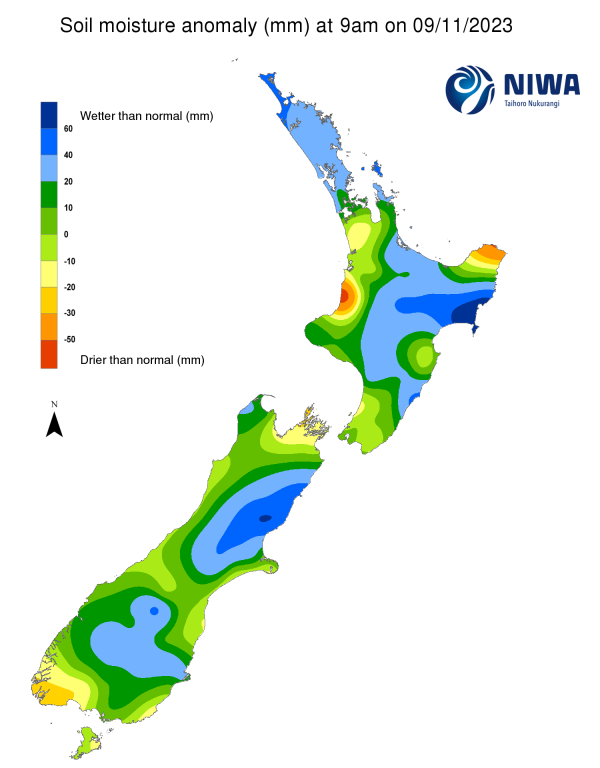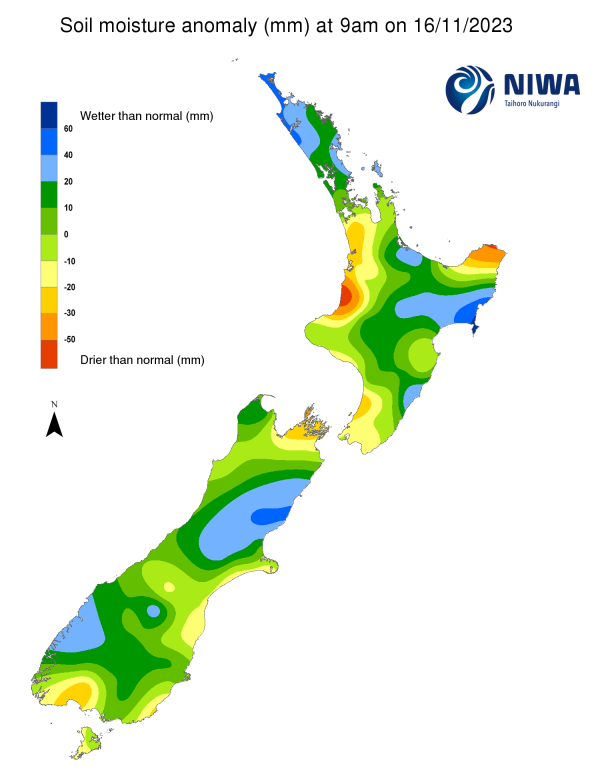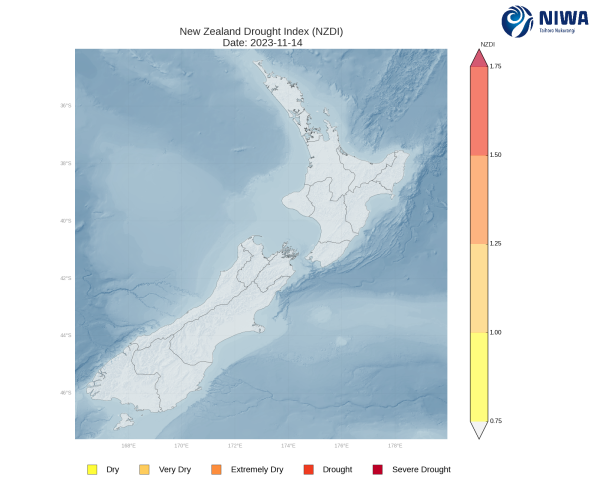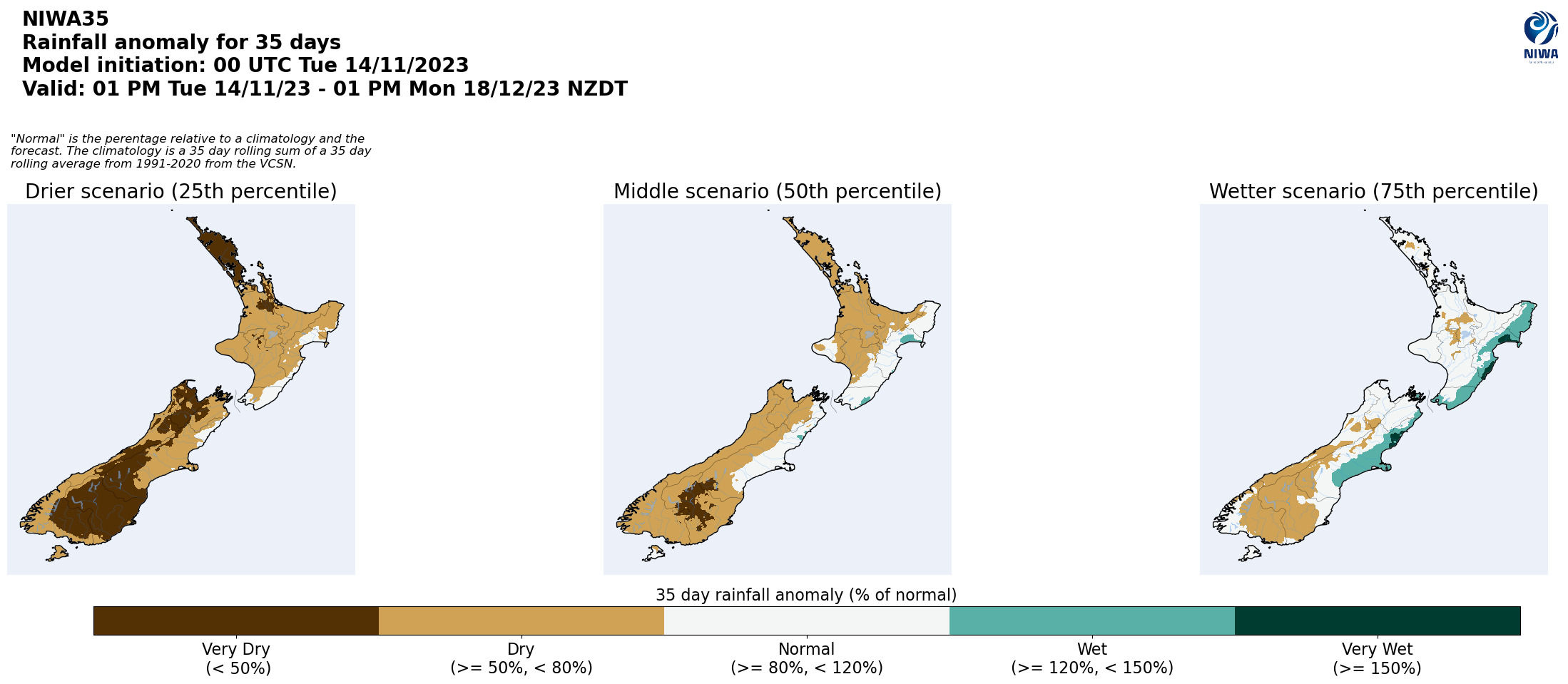A weekly update describing soil moisture patterns across the country to show where dry to extremely dry conditions are occurring or imminent. Regions experiencing significant soil moisture deficits are deemed “hotspots”. Persistent hotspot regions have the potential to develop into drought.
Recent rainfall and current soil moisture conditions:
North Island:
- Meagre rainfall was widespread across the North Island in the past week, with nearly all locations receiving less than 5 mm.
- This resulted in moderate soil moisture decreases across the entire North Island.
- The driest soils across the North Island, when compared to normal for this time of the year, are found in western Waikato and Kapiti Coast, while the wettest soils for this time of the year are found in southern Gisborne, northern Hawke’s Bay, and parts of the Far North.
- No hotspots currently exist in the North Island.
- As of 14 November, the New Zealand Drought Index (NZDI) map below shows that no unusually dry conditions are currently found across the North Island.
South Island:
- Rainfall amounts of 10 mm or less were widespread across the upper and eastern South Island in the past week.
- While the upper West Coast received 20-40 mm, the central West Coast received 40-80 mm.
- In addition, heavy rainfall of 150 mm or more was observed in much of Fiordland.
- This resulted in moderate soil moisture decreases across the upper and eastern South Island, with small to moderate increases observed in parts of the West Coast and Fiordland.
- The driest soils across the South Island, when compared to normal for this time of the year, are found in Marlborough Sounds, while the wettest soils for this time of the year are found in northern Canterbury.
- No hotspots currently exist in the South Island.
- As of 14 November, the New Zealand Drought Index (NZDI) map below shows that no unusually dry conditions are currently found across the South Island.


Pictured above: Soil Moisture Anomaly Maps, relative to this time of year. The maps show soil moisture anomalies over the past two weeks.
As of 14 November, the New Zealand Drought Index (NZDI) map below shows that no unusually dry conditions are currently found across the country. Please note: some hotspots in the text above may not correspond with the NZDI map. This difference exists because the NZDI uses additional dryness indices, including one which integrates the rainfall deficit over the past 60 days. Changes are therefore slower to appear in the NZDI compared to soil moisture anomaly maps that are instantaneously updated.

New Zealand Drought Index (NZDI) - 14 Nov 2023 [NIWA].
The week ahead:
North Island:
- Rain will gradually overspread the North Island on Saturday (18 November), with many areas seeing periods of at least moderate rain and thunderstorms on Sunday (19 November).
- The east coast will continue to see rain early next week, while areas farther to the west turn drier.
- The middle of next week looks drier overall as an area of high pressure moves overhead.
- Weekly rainfall totals of 40-70 mm will be widespread across much of the North Island, although amounts could be slightly less in Northland and Manawatū-Whanganui.
- However, isolated amounts greater than 100 mm may occur along the east coast.
- Due to the expected rainfall in the next week, most locations will likely see at least small soil moisture increases, while more substantial increases may occur along the east coast.
- No hotspots are expected to form in the North Island in the next week
South Island:
- Generally dry weather is expected through this weekend, although light rain may reach Marlborough Sounds and a handful of light showers are possible on Sunday afternoon (19 Noovember).
- High pressure will bring more dry weather for early-to-mid next week.
- By Thursday and Friday (23-24 November), a weak front may deliver a few more showers.
- Weekly rainfall totals of 30-50 mm are generally expected in the West Coast, with 15-30 mm commonplace elsewhere.
- Due to the expected rainfall in the next week, soil moisture levels may decrease at least slightly in a majority of the South Island.
- While no hotspots are expected to form in the next week, conditions may begin to approach hotspot criteria in Marlborough Sounds and the coast of central Canterbury.
Long-term outlook (through mid-December):
- The drier (25th percentile) and middle (50th percentile) rainfall scenarios both favour drier or much drier than normal conditions across much of the country, especially in the upper North Island and large swaths of the South Island.
- Even in the wetter (75th percentile) scenario, below normal rainfall is still favoured in parts of these same areas, although slightly wetter than normal conditions are now signalled in the east of both islands.
- In the drier rainfall scenario, there is a signal for dry conditions to emerge in pockets of both islands.


Pictured above: 35-day forecast rainfall anomaly scenarios (Top), and 35-day forecast dryness and drought scenarios (Bottom). These maps are updated daily at https://niwa.co.nz/climate/seasonal-climate-outlook
Background:
Hotspot Watch: a weekly advisory service for New Zealand media. It provides soil moisture and precipitation measurements around the country to help assess whether extremely dry conditions are imminent.
Soil moisture deficit: the amount of water needed to bring the soil moisture content back to field capacity, which is the maximum amount of water the soil can hold.
Soil moisture anomaly: the difference between the historical normal soil moisture deficit (or surplus) for a given time of year and actual soil moisture deficits.
Definitions: “Extremely” and “severely” dry soils are based on a combination of the current soil moisture status and the difference from normal soil moisture (see soil moisture maps at https://www.niwa.co.nz/climate/nz-drought-monitor/droughtindicatormaps)
Hotspot: A hotspot is declared if soils are "severely drier than normal" which occurs when Soil Moisture Deficit (SMD) is less than -110 mm AND the Soil Moisture Anomaly is less than -20 mm.

